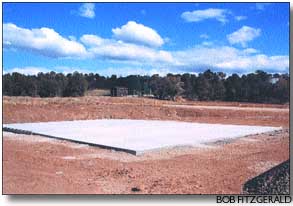|
November 15, 2001
By Jim Mimiaga A once-resolved controversy over funding for a fire substation on the remote and fire-prone Cedar Mesa Ranches subdivision has been rekindled. Developer Redstone Land Company is requesting that the Mancos Fire Protection District return a half-acre of land and $60,000 it provided to build a substation at the entrance to the countyís largest subdivision, located across the highway from Mesa Verde National Park. Redstone has since changed its name to Colorado Land and Ranches. In a Sept. 28 letter to the Montezuma County Commission, the companyís attorney, Kelly McCabe, said the fire district failed to begin building the station by a July 25 deadline stipulated in a settlement agreement between Redstone and the county. Therefore, the company is demanding that the money and land be refunded, according to Kelly McCabe. "We will probably re-open the lawsuit because there was an agreement that they would have completed construction within 12 months of the settlement," said McCabe. "(The Mancos Fire District) had not done anything until we sent them this notice, then they ran out there and started trying to get something done on it." A 90-day extension could have been applied for, but wasnít, McCabe said. But Lyle Cox, fire chief for the Mancos Fire Protection District, said that the money has already been spent, and that a concrete pad for the 1,200-square-foot building has already been poured. The modular building is on order and is expected to be installed by the first of the year, Cox said. "It has been a hassle (getting the money) and (the projectís) cost was kept to the $60,000," Cox said. "We canít afford to build that ourselves, as a volunteer department, and the substation will improve our response time to that subdivision." On hearing about Redstoneís claim for the refund, Cox said, "It doesnít surprise me ó they just donít care." The case has a long, confusing history made worse by vague Colorado laws regarding county control over subdivisions. In 1998, the Montezuma County Commission approved the subdivision after Redstone agreed to donate the land and $75,000 for a fire substation. The new substation was deemed essential for public safety by the Mancos Fire Protection District because the arid, 2,000-acre subdivision is prone to lightning strikes and lies on the far western edge of the district. Redstone, whose owners told the commissioners they had "no problem" with paying the $75,000, sent the county a letter of credit for that amount to be distributed to the fire district. Soon after, though, Redstone went to court to get the money back, arguing the county illegally coerced the company into the deal as a requirement for subdivision approval. The company said other county-approved subdivisions did not require developer-funded fire stations, and that Colorado law does not allow approval to be made conditional on a developer providing fire protection. Thatís true, but Montezuma County has repeatedly disputed the claim that a fire station was required for approval. County officials assert that Redstone freely entered into the agreement in order to solve the fire-safety concern and move forward with development. The county maintains that Redstoneís helping to build the substation was not a condition of subdivision approval and that the county entered into the fray only to help resolve the dispute. During public hearings, the commissioners felt that public-safety concerns brought up by the fire district were valid and deserved attention, but said they could not be specifically regulated by the county. In July 2000, the parties finally settled the lawsuit, with the county agreeing to refund $15,000 to Redstone. As part of the court order, a check for $60,000 was then disbursed by the county, which had been holding the Redstone funds, to the fire district. The funds were released only after the district promised in writing that the money would be used for building the station on the half-acre deeded to the district by Redstone. Cox said there were no time limits or contract stipulated with the money since the fire district was not a party in the suit. However, to add to the confusion, those provisions were specifically outlined in a settlement agreement between the county and Redstone. Redstone argues that although the agreement for a construction timetable was made with the county, the fire district is by association obligated to follow that specific agreement, but did not. They point to settlement language stating that if the Mancos district does not "execute an Agreement indicating its consent to this stipulation, the $60,000 sum . . . shall be refunded to Redstone Land Company," along with the half-acre of land. "I donít know why the county released the money without making them sign something," McCabe said. "My position is that if it gets built, the building and property will belong to Redstone." But Montezuma County attorney Bob Slough said the problem is between the Mancos Fire District and Redstone, not the county any more. He cited settlement language that states: "Upon the distribution of the . . . $60,000 by Montezuma County to Mancos Fire Protection District, the parties acknowledge that Montezuma County shall be released of any obligation or responsibilities relative to the funds distributed and earmarked for the construction of a fire substation." Said Slough, "We anticipated a problem between Redstone and Mancos Fire, thatís why we put that language in there." The quagmire highlights weak or non-existent state regulations giving counties authority to charge impact fees to developers for installing essential services. The state policy has been that governments can charge developer fees for roads but nothing else. That has left municipalities and counties in a Catch-22 situation. They canít legally require developers to pay for fire protection. But when subdivisions are approved against the advice of fire agencies, lawsuits may arise from homeowners who lose property to fire because of no nearby stations. |
||
|
Copyright © 2001 the Cortez Journal.
All rights reserved. |
